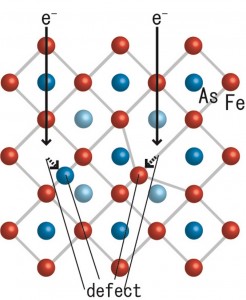Key to origin of iron-based superconductors observed Unique change of the number of superconducting electrons by electron irradiation

The research team of Assistant Professor Yuta Mizukami and Professor Takasada Shibauchi in the Department of Advanced Materials Science at the University of Tokyo Graduate School of Frontier Sciences and Assistant Professor Kenichiro Hashimoto in Institute for Materials Research at Tohoku University have clarified the electronic state of superconducting electrons in iron-based superconductors. This result was achieved by observing for the first time a non-monotonic change in the number of superconducting electrons with increasing dosage of electron irradiation in clean single crystals.

Schematic diagram of the defects (impurities) introduced by electron irradiation of the crystal. Vacancies (holes vacated by electrons) and interstitial defects (electrons slightly displaced from their original positions) are created by the collision of electrons and atoms. Defects are homogeneously distributed inside the whole crystal due to the small recoil energy of these collisions.
© 2014 Yuta Mizukami.
Iron-based superconductors were discovered in 2008, since when they have been the focus of intense research. Nevertheless, the superconducting symmetry, which is closely related to the mechanism of superconductivity, has not been determined. This result has clarified that the superconducting symmetry is s± (s plus-minus) symmetry, which had been theoretically suggested based on superconductivity mediated by spin fluctuations.
This result may lead to the design of superconducting materials demonstrating this mechanism for the discovery of superconductors with higher transition temperatures.
This research was conducted in collaboration with the group of Professor Yuji Matsuda in the Department of Physics at Kyoto University, and researchers at the Ecole Polytechnique, France and the University of Florida, USA.
This research was published online in the journal Nature Communications on 28 November 2014.
Press release (Japanese)
Paper
Y. Mizukami, M. Konczykowski, Y. Kawamoto, S. Kurata, S. Kasahara, K. Hashimoto, V. Mishra, A. Kreisel, Y. Wang, P. J. Hirschfeld, Y. Matsuda, T. Shibauchi,
“Disorder-induced topological change of the superconducting gap structure in iron pnictides”,
Nature Communications vol. 5, Article number 5657 (2014), doi: 10.1038/ncomms6657.
Article link (Publication)
Links
Graduate School of Frontier Sciences
Department of Advanced Materials Science, Graduate School of Frontier Sciences
Shibauchi Laboratory, Department of Advanced Materials Science, Graduate School of Frontier Sciences







